
Chernobyl tragedy day: 38 years since catastrophe
It's been 38 years since the largest man-made disaster of the 20th century, but Ukrainians still feel the echoes of the tragedy
It is on April 26 that the world annually commemorates the Chornobyl tragedy, one of the largest man-made disasters in world history. This day has also become a black page in the history of Ukraine, as it resulted in numerous casualties, and the consequences of the destruction and radioactive contamination caused significant damage not only to people but also to the environment. Kilometers of territory will be uninhabitable for several thousand, and sometimes tens of thousands of years. This day is an important reminder for the whole world about the safety of nuclear energy.
After the Chernobyl nuclear power plant (NPP) disaster in April 1986, about 150,000 square kilometers of land in Ukraine, Belarus, and Russia became contaminated with radioactive materials. This contaminated area extends north of the nuclear power plant for up to 500 kilometers. Particularly contaminated and deserted is the 30-kilometer-long area around the plant itself, which is called the "exclusion zone."
After the accident, radioactive substances were spread mainly in the northern hemisphere under the influence of winds and storms, and radioactive cesium affected 3/4 of the territory of Europe.
The Chornobyl accident
The Chornobyl disaster occurred on April 26, 1986, at the fourth power unit of the Chornobyl nuclear power plant in Ukraine, when nighttime testing activities were taking place. During this experiment, the situation got out of control, safety measures were neglected, and the reactor exploded, releasing tens of tons of radioactive materials into the environment. The fire that followed the explosion caused radiation to spread over long distances.

The Soviet authorities brazenly concealed the truth and tried to keep the information secret so that no one would know about the consequences of the Chornobyl disaster. However, on April 27, there was a sudden increase in the radiation background at the stations in Denmark and Sweden, and after checks, they realized that the cause was external contamination. This forced the Swedish authorities to appeal to the USSR for an explanation.
At the time, in radiation-contaminated Kyiv, the Soviet authorities organized a May Day demonstration to show the world that "nothing happened." At that time, the capital was recording significant exceedances of the radiation standard.
"According to the Republican Department for Hydrometeorological Environmental Control, the movement of air masses from the accident area caused an excess of natural background radiation in a number of regions by 20-2000 micro roentgens per hour (in Kyiv at 7:00 a.m. on 1 May 1986, 550-1200 micro roentgens per hour)," reads a certificate of the 6th Department of the KGB of the Ukrainian SSR dated May 1, 1986. This was reported by the BBC.
Thousands of people with children were taken to the streets to participate in this demonstration. This demonstration was an attempt by the authorities to divert attention from the true state of affairs and reassure the population.
"On April 26, 1986, at 01 hrs. 25 minutes, an explosion occurred in the premises of the 4th power unit of the Chernobyl NPP during its preparation for scheduled medium repairs, followed by a fire, which was soon extinguished. The explosion caused the collapse of the reactor cover and the roof of the machine room, and the roof of the 3rd power unit caught fire, which caused the latter to be shut down. By 6 p.m. on the same day, the fire on the roof of this power unit was also extinguished... Work is underway to localize the epicenter of the accident using helicopters. For the same purpose, radiation and chemical defense troops are involved," the KGB report on the Chornobyl disaster said.
The Chornobyl tragedy was a catastrophic reminder of the great risks associated with the use of nuclear energy. It also drew the world's attention to the need to strengthen safety measures in the nuclear industry and to the importance of further research into the effects of radiation contamination.
In September 2010, work began on laying the foundation for the sarcophagus over the destroyed fourth power unit of the Chernobyl nuclear power plant. A year later, in October, the construction of the Centralized Storage Facility for Spent Radiation Sources was also launched at the Vector site located in the Exclusion Zone. This project was aimed at creating a safe place for radioactive waste storage.
Subsequently, in 2019, a safe confinement was built to securely cover the area above the destroyed power unit. This huge project was implemented with the help of the United States and European countries and was an important step in ensuring safety and minimizing radiation exposure from the Chornobyl accident zone.

How many people were affected by the disaster?
We will probably never know the exact numbers, as much information was classified and remained in Moscow's archives, but it is clear to everyone that the consequences of the Chornobyl disaster were extremely serious.
According to the Ukrainian Institute of National Remembrance, 30 Chornobyl workers died in the explosion or as a result of acute radiation sickness in the first few months after the accident. The terrible consequences of the tragedy were felt by millions of people, as independent experts estimate that more than 500,000 people died from radiation, and more than 8.5 million people in Ukraine and neighboring countries received significant doses of radiation in the days after the disaster. Therefore, many more people have fallen victim to diseases caused by radiation.
More than 600 thousand people received the status of "liquidators". These unknown heroes risked their own lives fighting the fire and clearing the radioactive debris. The liquidators worked in extremely difficult conditions and were exposed to high levels of radiation.
Today, it is very important to remember the tragedy that took place at the Chornobyl Nuclear Power Plant. It reminds us of the lessons of the past and encourages us to increase our efforts in nuclear safety and environmental balance. This day is an eternal reminder to those who abuse and joke with the "atom".
May the memory of Chornobyl remind us of the need for caution and responsibility in working with nuclear technology, and may we keep the memory of those who fell victim to this disaster alive.
- News












































